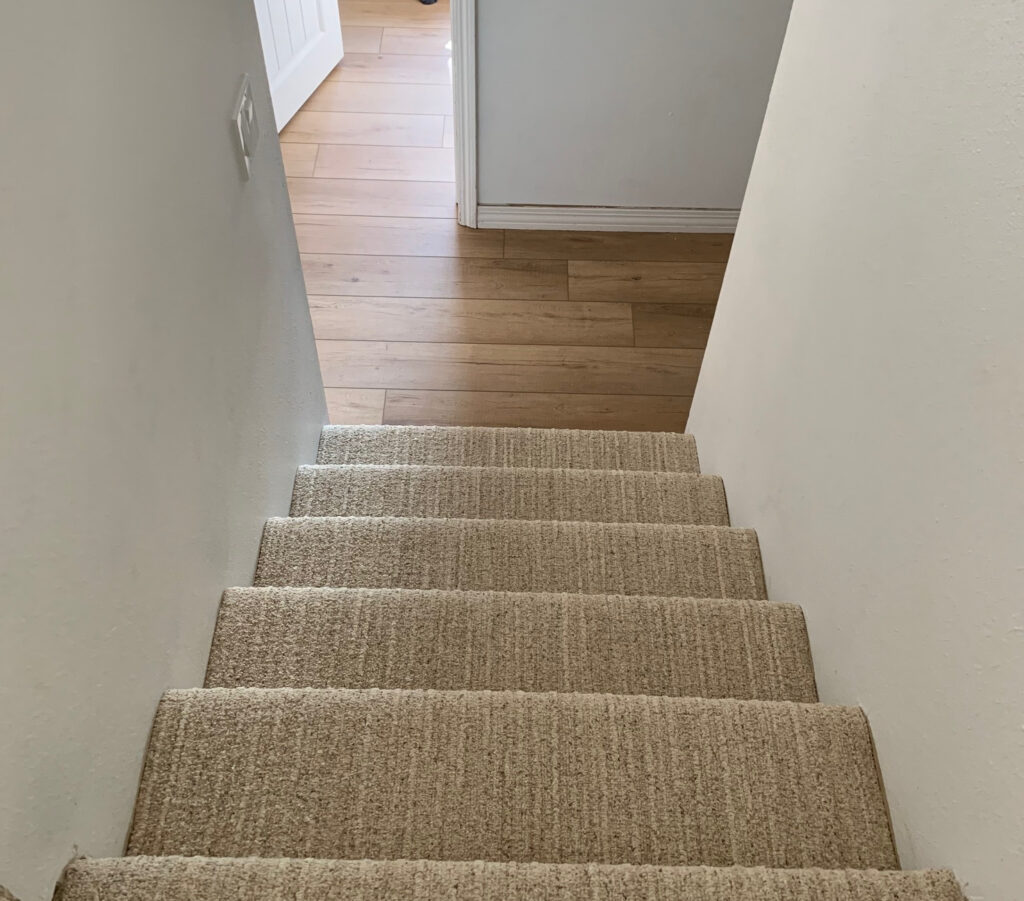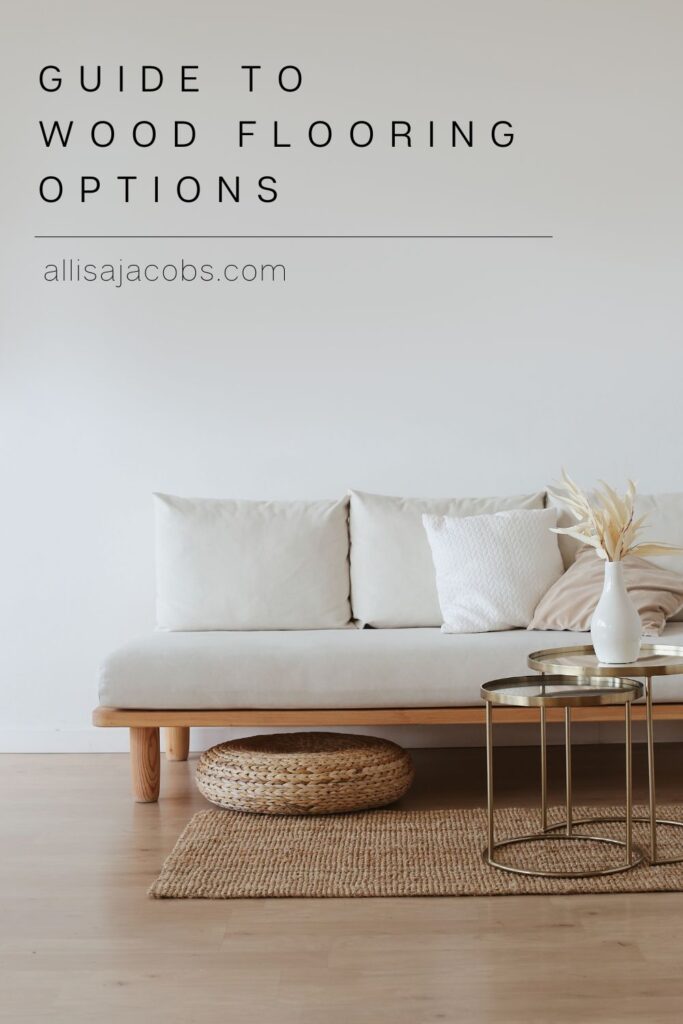Wood Flooring Options – A Comparison Guide
Besides wall paint, flooring is one of the most dramatic ways to update a space. It’s like an instant clean slate and changes the whole mood. Choosing the flooring, though, is not such an easy task. There are so many options and seemingly endless variables! After several flooring projects and countless hours of research, I came up with a guide of wood flooring options to compare and contrast

When considering all of the options out there, I think it’s helpful to consider flooring on a continuum. Starting at hardwood floors, through various synthetic and combination options, then all the way through to wood look tile. Wood flooring adds texture and line, two of the 7 Elements of Interior Design (read through for complete list).

Solid Hardwood Flooring:
This type of flooring is exactly like it sounds. The planks are cut from a single piece of lumber and solid wood all the way though.
Pros
Solid hardwood floors are a tried and true classic available in many different wood species (I’m partial to white oak). Because they’re made of solid wood all the way through, solid hardwood floors can be sanded and refinished over and over again.
Cons
Well, as you probably know, hardwood flooring is very expensive and labor intensive. Pricing can depend on geographic location and type of wood chosen. Additionally, hardwood floors have limitations on where it they should be installed.
They are not recommended for below grade install (meaning below level, like a basement) and anywhere else moisture would be an issue.

What Are Disadvantages of Hardwood Flooring?
If you’re asking yourself this question, check out my reflective post on 5 Things I Wish I Knew About Hardwood Floors. The main disadvantage to hardwood flooring is the cost and difficulty to install. It’s certainly not a DIY project – at least one for the faint of heart.

Engineered Hardwood Flooring:
You might’ve heard about this type but felt a little confused. I know I was initially. Engineered hardware is the next step from solid hardwood floors. It includes hardwood top layer (of various types of wood) and durable core bottom.
Pros
With engineered wood floors, you get the beauty of the hardwood top yet more water resistant. The bottom core layer means there are more options for installation than traditional hardwood.
Cons
Despite the common misconception, engineered hardwood flooring tends to be relatively expensive. Also, it is not waterproof and cannot be refinished indefinitely like solid hardwood. Some engineered wood includes a protective top layer and cannot be refinished at all.

Laminate Flooring
You’ve probably heard of laminate and have some visions of it’s 1980’s origins. Laminate flooring is made with a thin fiberboard core with an image of wood grain on top. It is sealed with a clear protective layer.
Pros
Laminate flooring is VERY cost effective and pretty simple to install with a click and lock design. It is also somewhat resistant to moisture and humidity. Bob Vila (who I’ve loved since I was a kid!), has a great step by step Laminate Flooring Installation Guide for DIY enthusiasts.
Cons
Has a wood look image, but laminate is not as realistic as other wood flooring options. It is often confused with Vinyl flooring (see below), but not as water resistant. Mr. Handyman has a great comparison of Laminate vs. Vinyl Flooring if you’re deciding between the two flooring options.

Vinyl Flooring:
Vinyl flooring is a synthetic flooring material often referred to a LVP (luxury vinyl plank) or LVT (luxury vinyl tile). The Flooring Store has a great Luxury Vinyl Flooring Guide to find the best vinyl flooring brands.
Pros
There are so many benefit to luxury vinyl flooring. There are so many options that look like natural wood. Vinyl flooring is easy to install with a click and lock design. It’s also relatively inexpensive and easy to install.

One huge bonus is that LVP Is generally waterproof so it can be installed in areas like a basement, which is why I chose it. It can also be installed on a concrete subgrade floor (unlike many other flooring options).
Cons
Although it’s super durable, vinyl flooring is not indestructible and can scratch, though newer versions are even more scratch resistant. Unlike hardwood or engineered hardwood, repair often means replacing an entire plank or two (which is why you always want to order 10% more than the actual square footage).

Bamboo Flooring:
Bamboo is technically a grass, but it functions like a hardwood which makes a good wood flooring option contender to mention.
Pros
As a natural material, Bamboo is considered very sustainable as it regrows very quickly. In addition to being more eco-friendly, it is also really durable.
Cons
Because it’s a natural and not synthetic, bamboo flooring tends to be fairly expensive. It’s also not suitable for below grade or basement applications. The Flooring Store really covers all the technical details of Bamboo Flooring I would recommend.

Ceramic Wood Look Tile:
Wood look tile is a ceramic or porcelain tile imprinted and colored to mimic natural wood variations.
Pros
Wood look tile is very durable and scratch resistant. It is also waterproof making it good option for kitchen or bathrooms in that regard.
Cons
Wood look Tile can be difficult to install (I mean, it’s tile! so you need consider grout and cutting pieces with a wet saw). Just like other tile, it will be very cold so depending on geographic location, that’s an important variable.

Common Wood Flooring Questions
Hopefully this guide helped compare many wood flooring options. Since there are a lot of common questions, let’s make sure we answer those while we’re at it!
Can I install wood floors on concrete?
Solid hardwood can be installed on concrete but it’s much more difficult and requires additional steps. An underlayment of wood is often need to nail the wood down. Also, prevent water damage with a moisture barrier.
However, many other flooring options easily install on concrete. Specifically, Luxury Vinyl Planks as it can ‘float’ on the concrete and is waterproof. I chose LVP for our basement living area.
Engineered hardwood can be installed on concrete though not recommended for a basement level since it’s not waterproof.
How to Clean Hardwood Floors?
Each type of flooring has it’s own cleaning recommendations, and solid hardwood floors are no exception. I created a completed guide on How to Care for Solid Wood Floors to help out.
Best Wood Flooring Options for Dogs
If dogs are part of your family, you’ll want to select more durable options that don’t scratch as easily. Laminate and LVP would be great for this reason. Not to mention waterproof for possible dog accidents.
If you want solid or engineered hardwoods, then at least choose a harder wood such as hickory, hard maple, or white oak. (Pine and fir are much softer and easier to scratch).

Looking for other home upgrades? Check out my 9 Easy Home Updates All Under $200 !

